 All's
well at RIL: Although the company comes out just ahead
in terms of coverage (a quality of exposure of 108), the very
fact that it boasts the highest image score should please
Chairman Mukesh Ambani, especially after 2004 when it received
more bad press than good All's
well at RIL: Although the company comes out just ahead
in terms of coverage (a quality of exposure of 108), the very
fact that it boasts the highest image score should please
Chairman Mukesh Ambani, especially after 2004 when it received
more bad press than good |
|
|
|
|
|
|
|
|
|
|
|
|
This
is a story about numbers, lots of them- suffice it to say that
visibility scores merely refer to the amount of press that a company
or CEO receives; image scores to the same, after taking into account
the tonality of the article in question; and quality of exposure
to the percentage value of the image score divided by the visibility
score (more than 100 for CEOs and companies that receive more
good press than bad and vice versa)-and it is a story about image,
and image management. Yet, at another level, it is also a story
about how India, as represented by its Fourth Estate, views Big
Business. Going by the numbers, then, business, in India, is fast
catching up with politics, Bollywood and cricket, the other obsessions
of the media (and the people). In 2004, the company with the highest
image score was Infosys Technologies (82,057); that with the highest
visibility score Reliance Industries (75,576). In 2005, there
were 25 companies whose image score exceeded 85,000 and 14 companies
whose visibility score exceeded 76,000. What does this mean? Simply
that the print media is writing more about business, and that
much of the coverage is positive, even (and unfortunately so)
laudatory and hagiographical at times. Indeed, that explains why
only two of the top 100 companies (by image scores) boast quality
of exposure (QoE) scores less than 100.
 The
Indian Hardware Story: Its performance in the booming
domestic PC market and renewed interest by multinationals
in the made-in-India tag ensured that HCL Infosystems (CEO
Ajai Chowdhry seen here) ended up with a QoE of 172 The
Indian Hardware Story: Its performance in the booming
domestic PC market and renewed interest by multinationals
in the made-in-India tag ensured that HCL Infosystems (CEO
Ajai Chowdhry seen here) ended up with a QoE of 172 |
While QoE is the measure of efficiency in
this case, it makes sense to base the ranking on total image score.
The company or CEO with the highest image score is, after all,
the entity or individual that received the most coverage. Reliance
Industries, #1 in this listing, has little reason to complain.
Its QoE may be just over 100 (108, actually), but it still means
the volume of good press the company received offset the volume
of bad press it did (only just). That's a significant improvement
over the last listing when the company ranked second and registered
a QoE of 91.5 (implying that it received more bad press than good).
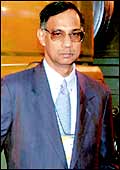 |
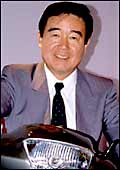 |
| High & Low: Ashok Leyland
(CEO R. Seshasayee, left) didn't receive much press, but almost
all it did was positive (QoE: 168), while HMSI (CEO H. Takiguchi)
received a lot, with most being negative (QoE: 37) |
The best image managers aren't necessarily
those companies and CEOs that boast QoE scores nearing 200 (a
score of 200 would imply that all press they receive is good press).
The best image managers are those companies and individuals who
receive a lot of press, with most of it being positive. In number
terms that would translate into a QoE in excess of 140. As the
listing shows, that (a score in excess of 140) isn't all that
rare.
Still, a QoE score close to 200 is a significant
achievement. Cognizant Technology Solutions (see India it's New
Billion Dollar Baby on page 70 to understand why the company keeps
receiving good press) doesn't merely boast a QoE of 189, it does
that on a visibility score of 36,085. The same applies to TVS
Motor, which registered a QoE of 165 on a visibility score of
43,358.
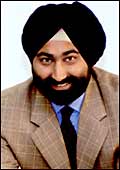 |
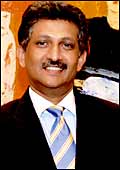 |
| Luck and Timing: Despite
it being annus horribilis for Ranbaxy (MD Malvinder Singh,
left), it was #1 in terms of image score in its industry,
and a great year for retail and a successful IPO saw Shoppers'
Stop (CEO B.S. Nagesh) earn the honours in its |
Last year, 2005, was when sectors such as
it (from the point of view of offshoring), auto, telecom, banking,
retail, insurance (the booming domestic market), aviation (the
entry of several low-cost airlines) and fast moving consumer goods
(the great revival) made all the news (or much of it). The interesting
thing about it (which is #1 in terms of sectors that made the
most news) is that it has emerged the most global of businesses
in India. At least five multinationals (which have operations
in India that range from mid-sized to large) feature in the list
of the top 10 companies in the sector (by image scores).
Now for HMSI (Honda Motorcycle & Scooter
India): the company received lots of press last year (a visibility
score of 53,763), but much of this was negative. This was because
most coverage it received had to do with a strike that went horribly
wrong (striking employees beat up some cops; the cops extracted
a bloody vengeance; the company, caught in the middle, bore the
brunt of the criticism). Still, such things are quickly forgotten.
Coca-Cola India and PepsiCo India were not in the top 50 (by image
scores) last year. This year, they figure at #46 and #32, respectively.
QED.
| METHODOLOGY |
| VISIBILITY SCORE: This is a function
of the size of the article, its position in the publication
(cover story, first page, etc.) and the readership of the
publication.
IMAGE SCORE: Visibility scores for each article
are multiplied by 1, 2 or -1 depending on whether the article
is neutral, positive or negative.
QUALITY OF EXPOSURE: This determines the relationship
between visibility score and image score. Mathematically,
it is the image score divided by the visibility score expressed
as a percentage. Thus, a QoE of around 100 per cent indicates
that the coverage has been largely neutral, a score significantly
higher than 100 per cent that the coverage has been largely
positive, and that significantly lower than 100 per cent
that the coverage has been largely negative.
CATEGORIES: The scores are pigeonholed across various
industries (banking, consumer durables, automotive, telecom,
etc.).
GENRES: The scores are pigeonholed across various
genres (marketing and sales, finance and financial results,
corporate, product launches, personalities, etc.).
COVERAGE: English and vernacular newspapers. And
English and vernacular magazines. Unlike the coverage of
politics, sports or entertainment, that of business is still
dominated by the print medium.
TIME PERIOD: January 1, 2005 to December 31, 2005.
|
The Top Personalities
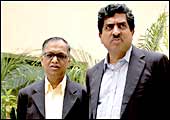 |
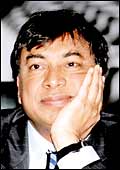 |
| Infosys' #1 and #2: Chairman Murthy
(left) and CEO Nilekani were a study in contrasts as far as
their image scores and QoE scores were concerned |
Indian Number 1: L.N. Mittal's ambitious
plans for an India-plant had everyone agog |
It is difficult to keep N.R. Narayana
Murthy out of the news. If the Chairman of Infosys Technologies
isn't taking on the state government over its obvious neglect
of Bangalore, he is busy clashing with politicians. Two years
ago, it was Murli Manohar Joshi, the then HRD Minister, over the
autonomy of the Indian Institute of Management, Ahmedabad. Last
year, it was H.D. Deve Gowda, the former Prime Minister of India
who made some uncharitable comments about Murthy's contribution
to Bangalore International Airport Limited, of which he (Murthy)
was Chairman at the time. Murthy was also in the news for other
reasons. He wrote about how the death of former Prime Minister
Rajiv Gandhi moved him in a mainstream national daily, something
that was seen by some people as an attempt to cosy up to Congress
leader Sonia Gandhi. And he reiterated a desire, first expressed
a few years ago, about becoming India's Ambassador to the United
States after he steps down as Chairman of Infosys in mid-2006.
The interesting thing is, all these did make him very very visible
in the pages of the print media, but not all the coverage was
positive. Thus, he ended 2005 with a visibility score of 29,570,
an image score of 34,055 and a quality of exposure (QoE) of 115.
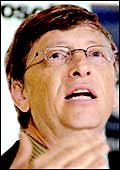 |
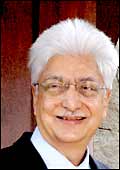 |
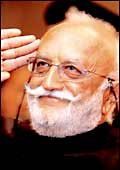 |
| St Bill of Microsoft: Gates made the
headlines repeatedly during his business-cum-charity visit |
Still up there: Wipro's Azim Premji
can give some lessons on how to be low profile yet well thought
of |
Higher still: Vijaypat Singhania's hot-air
balloon exploits made him a corporate hero |
His colleague from Infosys, Nandan Nilekani, President, CEO and
Managing Director, did much better. He did not get written about
a lot (only eight other personalities in the top 25 list had visibility
scores lower than his 5,756), yet his image score, 8,881, ensured
that his QoE was 154 (which immediately puts him in the top five
on the basis of that parameter).
The personality who ended up #1 on the list, L.N. Mittal, earned
that position largely on the strength of a visit to India to announce
that his company, Mittal Steel, would set up a plant in Jharkhand.
And the personality at #3 on the list (who turns out to be the
only non-Indian on the list), Bill Gates, on the strength of a
week-long trip to India in early December.
Despite more women entering senior executive positions in India-as
this magazine routinely reports in its special issues on the most
powerful women in Indian business-there is just one woman in the
top 25, Biocon Chairman Kiran Mazumdar-Shaw. And the fact that,
a few days of concerted press coverage could propel one into the
most-written-about category was proved by Vijaypat Singhania,
the former chief of Raymond, whose successful attempt at breaking
the record for the highest altitude registered in a hot-air balloon
flight seems to have pushed him to #7 on the listing.
The real winner, though, would have to be Sun Pharma's Dilip
Shanghvi. His company beat the prevailing trend (of Indian pharma
firms, especially those dependant on a generics-driven strategy,
not doing too well) by continuing to do well. And the man himself
ended the year with a QoE score of 198 (which means 99 per cent
of the coverage he received was positive). HCL Technologies' reclusive-by-location
Chairman, Shiv Nadar (he speaks to the press when he can, but
is based in California for most part of the year), also did well
for himself, with a QoE of 189. On a visibility score of 3,301,
that isn't bad going.
In The Newsroom
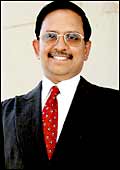 |
 |
| IBM's Shankar Annaswamy (L)
and UB's Vijay Mallya: The former's India-plans seem to
have found favour with most people as have the latter's success
at acquiring Shaw Wallace's spirits business and launching
a low-cost airline, Kingfisher |
Shankar Annaswamy, take a bow. There's
a reason why the head of IBM's Indian operations should feel pretty
chuffed with himself. The way a company is written about in the
editorial pages of the newspaper-one where editors get to express
their opinions, and show-off their depth of knowledge and acuity
of analysis-is, more often than not, a reflection of public opinion
(the way it is or the way it should be). From that point of view,
IBM, which got written about a bit (visibility score of 494 on
the edit pages), did very well for itself. It ended the year with
a quality of exposure (QoE) score of 174. Just for the record,
#2, Microsoft, did 138. And IBM wasn't helped by a high-profile
CEO visit like Microsoft was (fine Bill Gates isn't CEO, but more
people in India associate his name with Microsoft's than they
do Steve Ballmer's). Although its CEO Sam Palmisano did make a
trip to India, his visit was low profile (and he did not even
meet the media). That would mean that much of the coverage IBM
received had to do with its local operations and its India strategy.
Which would, in turn, mean that CEO Shankar Annaswamy should feel
chuffed. After all, being seen positively, very positively, by
people at large is some achievement for a company that exited
India in the late 70s because it didn't see eye-to-eye with the
government of the day's policies.
Mastering The Yo-Yo
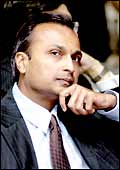 |
| Down and Up: Reliance Infocomm's
Anil Ambani has seen the company's perception improve from
an all-time low QoE of 75 |
Spare a thought for Anil Ambani.
He began the year an underdog in his fight with elder brother
Mukesh Ambani over the control of the Reliance empire. He managed
a reasonably fair settlement in the middle of the year, with the
jewel in his empire being Reliance Infocomm, a company that had
been mid-wifed and grown into a position of strength by Mukesh.
However, it was also a company that had been in the news for much
of the early part of the year over alleged corporate governance
violations and an alleged shares-for-favours transaction with
former Communications Minister Pramod Mahajan. Not surprisingly,
the company's quality of exposure (QoE) score in March 2005 was
75, implying that a substantial portion of the significant coverage
(visibility score of 12,749) it received that month was negative.
Since the settlement, though, Reliance Info's QoE has improved
(the company ended December with a QoE of 153 for the month and
119 for the entire year). It is likely that the phone-tapping
controversy involving one of the company's junior executives may
dent that some; still, it has to be labelled a comeback story.
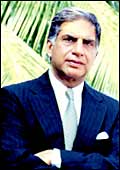 |
| Still on top: The best-known
Indian business group, Tata, is still the most written about
and is well thought of |
Tata-Birla? Not quite
In one of those language-plays
the Tatas and the Birlas were the A and B of the Indian business
alphabet for a long time. That position has since changed. There
are now several Birla Groups, with the largest, the Kumar Mangalam
Birla-led Aditya Birla Group, being large enough, diverse enough
(in terms of businesses) and profitable enough to be compared
with the Tata Group. However, in 2005, the group didn't get written
about enough to figure in the listing of the top five groups (by
image scores). The Tata Group did, as did Reliance (which will,
from this year on, be seen as two groups, one, RIL and other companies
headed by Mukesh Ambani and the other Anil Ambani's ADAE), Bharti,
Sahara and Bajaj. It isn't hard to understand the reason for the
Tata Group's high image score (512,847). Last year, 2005, saw
the Tata Group increase its global footprint; the large companies
in the group (including Tata Motors, Tata Steel and Tata Consultancy
Services) managed to do very well (in terms of financial performance);
and even the small companies chipped in (retailer Trent, for instance,
made the news by acquiring Landmark, arguably India's best bookstore
chain).
GUEST
COLUMN/SOURAV
DE, HEAD, CIRRUS
Need To Hike Pr Budgets |
 The
media evaluation industry grew by 80 per cent in 2005 over
2004. More and more companies are presenting image assessment
reports in meetings of the board. Competitive benchmarking
and neutral third party analysis are becoming essential features
of standard communication briefs. The PR (public relations)
industry is getting used to being evaluated. The
media evaluation industry grew by 80 per cent in 2005 over
2004. More and more companies are presenting image assessment
reports in meetings of the board. Competitive benchmarking
and neutral third party analysis are becoming essential features
of standard communication briefs. The PR (public relations)
industry is getting used to being evaluated.
The science of evaluation has also evolved. PR is all
about messages: delivering the right message to the target
audience, and influencing them to understand and react in
a particular way. Any effort at evaluating the media effectiveness
of corporate communications, then, must evaluate each of
these steps.
Today it is possible to assess if a message intended for
women between the ages of 15 and 29, and from SEC A1 (the
highest socio-economic classification) households has been
delivered to the target audience.
Interestingly, the biggest challenge in implementing such
high standards of scrutiny is not the initial resistance
from the PR fraternity, but its affordability given the
budgets constraints.
Not surprisingly, Indian PR budgets are abnormally low
by international standards. A recent study (GAP III) conducted
by the USC Annenberg Strategic Public Relations Center and
sponsored by the Council of Public Relations Firms shows
that PR budgets for Fortune 500 firms are around 40 per
cent of their advertising budgets. In addition, these firms
spend an average of more than Rs 2 crore on evaluation.
The ratio is much higher if the sample is expanded (indicating
that smaller firms often end up spending much higher proportions
of their marketing spend on PR in an effort to build image,
a surprise finding, but wholly logical).
The corresponding number in India is 2 per cent (of the
advertising budget being spent on PR) and that is for the
large companies. For smaller firms, the proportion could
be 0.5 per cent, even lower.
It's difficult to explain this drought of funds because
C-suites in most Indian organisations are extremely sensitive
to media coverage. One big reason seems to be the lack of
scientific data demonstrating effectiveness in the absence
of which, senior managers are loath to spend on PR.
In some ways, the annual BT-Cirrus review (this is the
third edition of the exercise) is an evaluation of PR agencies
and how well they have communicated the desired message.
The best PR agencies are those that have maintained a balance
between visibility, image and quality of exposure.
Internationally, more and more companies are accepting
the merits of evaluation. One survey, Harris Impulse 2004,
discovered that 76 per cent of respondents believed it was
important to measure the results (of PR campaigns). This
(measuring results) ranked 10 among 28 parameters considered
while evaluating the performance of a PR firm. The corresponding
numbers in the 2001 edition of the survey were 35 per cent
and 25, respectively.
More importantly, it would appear that the responsibility
for corporate communications is slowly coming to rest with
C-suites. The GAP III survey finds that 57 per cent of the
respondents (all PR professionals) reported to the CEO,
COO or Chairman.
In India too, the PR department is getting closer to the
C-suite. As this phenomenon catches on, the importance assigned
to PR will increase, as will the amount of money dedicated
to it. That should help to reduce the gap between PR budgets
(as a proportion of advertising budgets) in India and the
US. And that would mean that PR budgets in India would have
to grow faster than the 9 per cent a year rate at which
they are growing internationally.
Cirrus is a national corporate image monitor that pioneered
media evaluation in India. Every year, Cirrus analyses roughly
half-a-million news pieces in nine different languages on
more than 920 corporate entities. It is part of agencyfaqs
and not associated with any PR agency. The BT-Cirrus annual
survey is the only cross industry report of its kind.
Feedback to bt-cirrus@icirrus.com
|
|




 All's
well at RIL: Although the company comes out just ahead
in terms of coverage (a quality of exposure of 108), the very
fact that it boasts the highest image score should please
Chairman Mukesh Ambani, especially after 2004 when it received
more bad press than good
All's
well at RIL: Although the company comes out just ahead
in terms of coverage (a quality of exposure of 108), the very
fact that it boasts the highest image score should please
Chairman Mukesh Ambani, especially after 2004 when it received
more bad press than good The
Indian Hardware Story: Its performance in the booming
domestic PC market and renewed interest by multinationals
in the made-in-India tag ensured that HCL Infosystems (CEO
Ajai Chowdhry seen here) ended up with a QoE of 172
The
Indian Hardware Story: Its performance in the booming
domestic PC market and renewed interest by multinationals
in the made-in-India tag ensured that HCL Infosystems (CEO
Ajai Chowdhry seen here) ended up with a QoE of 172












 The
media evaluation industry grew by 80 per cent in 2005 over
2004. More and more companies are presenting image assessment
reports in meetings of the board. Competitive benchmarking
and neutral third party analysis are becoming essential features
of standard communication briefs. The PR (public relations)
industry is getting used to being evaluated.
The
media evaluation industry grew by 80 per cent in 2005 over
2004. More and more companies are presenting image assessment
reports in meetings of the board. Competitive benchmarking
and neutral third party analysis are becoming essential features
of standard communication briefs. The PR (public relations)
industry is getting used to being evaluated.